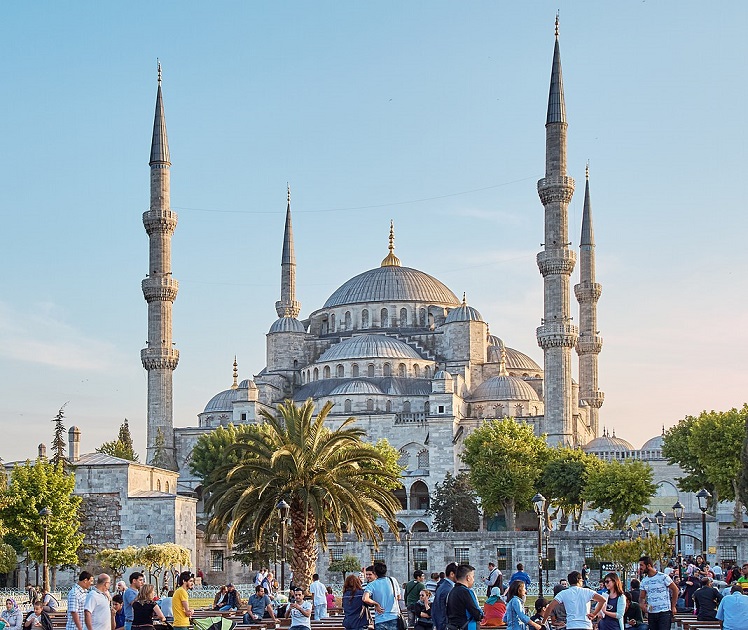Summary | Excerpt | Reviews | Beyond the Book | Read-Alikes | Genres & Themes | Author Bio

A Novel
by Abdulrazak GurnahThis article relates to Theft
 In Abdulrazak Gurnah's novel Theft, multiple characters dream of seeing the world, but only some have the privilege of doing so in reality. Badar, whose economic situation puts travel out of reach, keeps a photograph of the Blue Mosque in Istanbul on the wall of his rented room as a symbol of that dream. The Blue Mosque is one of the most incredible structures surviving from the Ottoman Empire. Though commonly referred to by this moniker due to the interior color scheme, the actual name of the building is the Sultan Ahmed Mosque, after its commissioner, Ahmed I. It was built in what was at the time the central area of the city, near many other important landmarks, such as the Topkapi Palace, Hagia Sophia, and Grand Bazaar.
In Abdulrazak Gurnah's novel Theft, multiple characters dream of seeing the world, but only some have the privilege of doing so in reality. Badar, whose economic situation puts travel out of reach, keeps a photograph of the Blue Mosque in Istanbul on the wall of his rented room as a symbol of that dream. The Blue Mosque is one of the most incredible structures surviving from the Ottoman Empire. Though commonly referred to by this moniker due to the interior color scheme, the actual name of the building is the Sultan Ahmed Mosque, after its commissioner, Ahmed I. It was built in what was at the time the central area of the city, near many other important landmarks, such as the Topkapi Palace, Hagia Sophia, and Grand Bazaar.
Construction began in 1609 and completed in 1616. The mosque was designed by Sedefkar Mehmed Ağa, who was the Ottoman court's royal architect at the time. His design was inspired in part by the nearby Hagia Sophia, which had been built during the Byzantine Empire, more than a thousand years prior. The mosque is composed of a large central dome reaching 141 feet high and 77 feet in diameter. This is surrounded by four semidomes and multiple smaller domes. It also has six surrounding minarets, used for calls to prayer. When it was built, the decision to construct six rather than the more usual four was controversial, because it put the building on the same level of grandeur as the Great Mosque in Mecca. Ahmed responded by having a seventh minaret added to the Great Mosque, thereby maintaining its prestige without compromising on the design for his new building.
The interior of the mosque is as stunning as the exterior. It is decorated with more than 20,000 hand-painted ceramic tiles depicting plants and flowers, abstract geometric designs, and verses from the Quran. The walls and domes also contain over 250 stained glass windows with similar designs. While blue is the most dominant color, it is complemented by many others, including green, red, and turquoise, to make a bright, beautiful space. The minbar—the platform from which the imam speaks—is made of carved marble and expertly placed to take advantage of the building's acoustics.
In 1985 the mosque was named a UNESCO World Heritage Site. An extensive five-year restoration effort was completed in 2023. Preservation work was done on both the interior paintings and exterior elements such as the minarets, along with the expansion of facilities to improve the site's ability to accommodate the volume of visitors it receives (4-5 million per year), such as additional bathrooms in the gardens. Today, it is a place of daily worship as well as a very popular tourist destination. Visitors are asked to be respectful of the religious significance of the building by following the stated dress code and being aware that it closes to non-Muslim tourists during daily prayer times and other religious events.
The Blue Mosque in Instanbul, photo by Pedro Szekely, CC BY-SA 2.0
Filed under Places, Cultures & Identities
![]() This article relates to Theft.
It first ran in the March 26, 2025
issue of BookBrowse Recommends.
This article relates to Theft.
It first ran in the March 26, 2025
issue of BookBrowse Recommends.
Your guide toexceptional books
BookBrowse seeks out and recommends the best in contemporary fiction and nonfiction—books that not only engage and entertain but also deepen our understanding of ourselves and the world around us.